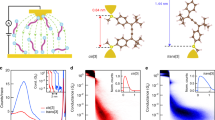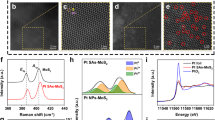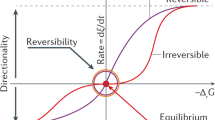Abstract
Oriented external electric fields (OEEFs) as 'smart reagents' are no longer a theoretical dream. Here, we discuss the wide-ranging potential of using OEEFs to catalyse and control a variety of non-redox reactions and impart selectivity at will. An OEEF along the direction of electron reorganization (the so-called reaction axis) will catalyse nonpolar reactions by orders of magnitude, control regioselectivity and induce spin-state selectivity. Simply flipping the direction of the OEEF or orienting it off of the reaction axis, will control at will the endo/exo ratio in Diels–Alder reactions and steps in enzymatic cycles. This Perspective highlights these outcomes using theoretical results for hydrogen abstraction reactions, epoxidation of double bonds, C–C bond forming reactions, proton transfers and the cycle of the enzyme cytochrome P450, as well as recent experimental data. We postulate that, as experimental techniques mature, chemical syntheses may become an exercise in zapping oriented molecules with OEEFs.
This is a preview of subscription content, access via your institution
Access options
Subscribe to this journal
Receive 12 print issues and online access
$259.00 per year
only $21.58 per issue
Buy this article
- Purchase on Springer Link
- Instant access to full article PDF
Prices may be subject to local taxes which are calculated during checkout







Similar content being viewed by others
References
Aragonés, C. et al. Electrostatic catalysis of a Diels–Alder reaction. Nature 531, 88–91 (2016).
Meir, R., Chen, H., Lai, W. & Shaik, S. Oriented electric fields accelerate Diels–Alder reactions and control the endo/exo selectivity. ChemPhysChem 11, 301–310 (2010).
Shaik, S., de Visser, S. P. & Kumar, D. External electric field will control the selectivity of enzymatic-like bond activations. J. Am. Chem. Soc. 126, 11746–11749 (2004).
Hirao, H., Chen, H., Carvajal, M. A., Wang, Y. & Shaik, S. Effect of external electric fields on the C−H Bond activation reactivity of nonheme iron−oxo reagents. J. Am. Chem. Soc. 130, 3319–3327 (2008).
Lai, W., Chen, H., Cho, K.-B. & Shaik, S. External electric field can control the catalytic cycle of cytochrome P450cam: a QM/MM Study. J. Phys. Chem. Lett. 1, 2082–2087 (2010).
Gorin, C. F., Beh, E. S. & Kanan, M. W. An electric field-induced change in the selectivity of a metal oxide-catalyzed epoxide rearrangement. J. Am. Chem. Soc. 134, 186–189 (2012).
Gorin, C. F., Beh, E. S., Bui, Q. M., Dick, G. R. & Kanan, M. W. Interfacial electric field effects on a carbene reaction catalyzed by Rh porphyrins. J. Am. Chem. Soc. 135, 11257–11265 (2013).
Susarrey-Arce, A. et al. A new ATR-IR microreactor to study electric field-driven processes. Sensors and Actuators B: Chemical 220, 13–21 (2015).
Hiberty, P. C., Megret, C., Song, L., Wu, W. & Shaik, S. Barriers for hydrogen vs. halogen exchange — an experimental manifestation of charge-shift bonding. J. Am. Chem. Soc. 128, 2836–2843 (2006).
Fried, S. D. & Boxer, S. G. Measuring electric fields and noncovalent interactions using the vibrational stark effect. Acc. Chem. Res. 48, 998–1006 (2015).
Oklejas, V., Sjostrom, C. & Harris, J. M. SERS detection of the vibrational stark effect from nitrile-terminated SAMs to probe electric fields in the diffuse double-layer. J. Am. Chem. Soc. 124, 2408–2409 (2002).
Franzen, S., Goldstein, R. F. & Boxer, S. G. Electric field modulation of electron transfer reaction rates in isotropic systems: long distance charge recombination in photosynthetic reaction centers. J. Phys. Chem. 94, 5135–5149 (1990).
Lao, K., Franzen, S., Stanley, R. J., Lambright, D. G. & Boxer, S. G. Effects of applied electric fields on the quantum yields of the initial electron-transfer steps in bacterial photosynthesis. 1. quantum yield failure. J. Phys. Chem. 97, 13165–13171 (1993).
Murgida, D. H. & Hildebrandt, P. Electron-transfer processes of cytochrome c at interfaces. New insights by surface-enhanced resonance raman spectroscopy. Acc. Chem. Res. 37, 854–861 (2004).
Wahadoszamen, M., Nakabayashi, T., Kang, S., Imahori, H. & Ohta, N. External electric field effects on absorption and fluorescence spectra of a fullerene derivative and its mixture with zinc-tetraphenylporphyrin doped in a PMMA film. J. Phys. Chem. B 110, 20354–20361 (2006).
Ohta, N., Koizumi, M., Umeuchi, S., Nishimura, Y. & Yamazaki, I. External electric field effects on fluorescence in an electron donor and acceptor system: ethylcarbazole and dimethyl terephthalate in PMMA polymer films. J. Phys. Chem. 100, 16466–16471 (1996).
Son, Y. W., Cohen, M. L. & Louie, S. G. Half-metallic graphene nanoribbons. Nature 444, 347–349 (2006).
Naaman, R., Waldeck, D. H. Spintronics and chirality: spin selectivity in electron transport through chiral molecules. Annu. Rev. Phys. Chem. 66, 263–281 (2015).
Hishikawa, A., Iwamae, A. & Yamanouchi, K. Ultrafast deformation of the geometrical structure of CO2 induced in intense laser fields. Phys. Rev. Lett. 83, 1127–1130 (1999).
Alemani, M. et al. Electric field-induced isomerization of azobenzene by STM. J. Am. Chem. Soc. 128, 14446–14447 (2006).
Darwish, N., Aragonès, A. C., Darwish, T., Ciampi, S. & Díez-Pérez, I. Multi-responsive photo- and chemo-electrical single-molecule switches. Nano Lett. 14, 7064–7070 (2014).
Harzmann, G. D., Frisenda, R., van der Zant, H. S. & Mayor, M. Single-molecule spin switch based on voltage-triggered distortion of the coordination sphere. Angew. Chem. Int. Ed. 54, 13425–13430 (2015).
Pocker, Y. & Buchholz, R. F. Electrostatic catalysis by ionic aggregates. II. Reversible elimination of hydrogen chloride from tert-butyl chloride and the rearrangement of 1-phenylallyl chloride in lithium perchlorate-diethyl ether solutions. J. Am. Chem. Soc. 92, 4033–4038 (1970).
Shaik, S. S. What happens to molecules as they react? A valence bond approach to reactivity. J. Am. Chem. Soc. 103, 3692–3701 (1981).
Shaik, S. & Shurki, A. Valence bond diagrams and chemical reactivity. Angew. Chem. Int. Ed. 38, 586–625 (1999).
Pross, A. & Shaik, S. S. A qualitative valence bond approach to organic reactivity. Acc. Chem. Res. 16, 363–370 (1983).
Cho, K.-B. et al. Compound I in heme thiolate enzymes: a comparative QM/MM study. J. Phys. Chem. A 112, 13128–13138 (2008).
Dandamudi, U. et al. A single-site mutation (F429H) converts the enzyme CYP 2B4 to a heme-oxygenase: a QM/MM study. J. Am. Chem. Soc. 134, 4053–4056 (2012).
Warshel, A., Sharma, P. K., Kato, M., Xiang, Y., Liu, H. & Olsson, M. H. M. Electrostatic basis for enzyme catalysis. Chem. Rev. 106, 3210–3235 (2006).
Warshel, A. Electrostatic basis of structure-function correlation in proteins. Acc. Chem. Res. 14, 284–290 (1981).
Fried, S. D., Bagchi, S. & Boxer, S. G. Extreme electric fields power catalysis in the active site of ketosteroid isomerase. Science 346, 1510–1514 (2014).
Liu, C. T. et al. Probing the electrostatics of active site microenvironments along the catalytic cycle for escherichia coli dihydrofolate reductase. J. Am. Chem. Soc. 136, 10349–10360 (2014).
Gryn'ova, G., Marshall, D. L., Blanksby, S. J. & Coote, M. L. Switching radical stability by pH-induced orbital conversion. Nat. Chem. 5, 474–481 (2013).
Klinska, M., Smith, L. M., Gryn'ova, G., Banwell, M. G. & Coote, M. L. Experimental demonstration of pH-dependent electrostatic catalysis of radical reactions. Chem. Sci. 6, 5623–5627 (2015).
Sowlati-Hashjin, S. & Matta, C. The chemical bond in external electric fields: energies, geometries, and vibrational Stark shifts of diatomic molecules. J. Chem. Phys. 139, 144101 (2013).
De Biase, P. M. et al. Molecular basis for the electric field modulation of cytochrome c structure and function. J. Am. Chem. Soc. 131, 16248–16256 (2009).
Karafiloglou, P. Control of delocalization and structural changes by means of an electric field. J. Comput. Chem. 27, 1883–1891 (2006).
Wei, Y. et al. A theoretical study of the activation of nitromethane under applied electric fields. RSC Adv. 6, 24712–24718 (2016).
Schirmer, B. & Grimme, S. Electric field induced activation of H2 — can DFT do the job? Chem. Commun. 46, 7942–7944 (2010).
Shaik, S., Kumar, D., de Visser, S. P., Altun, A. & Thiel, W. Theoretical perspective on the structure and mechanism of cytochrome P450 enzymes. Chem. Rev. 105, 2279–2328 (2005).
Ortiz de Montellano, P. R. & De Voss, J. J. Oxidizing species in the mechanism of cytochrome P450. Nat. Prod. Rep. 19, 477–493 (2002).
Shaik, S., Lai, W., Chen, H., Wang, Y. The valence bond way: reactivity patterns of cytochrome P450 enzymes and synthetic analogs. Acc. Chem. Res. 43, 1154–1165 (2010).
Shaik, S., Milko, P., Schyman, P., Usharani, D. & Chen, H. Trends in aromatic oxidation reactions catalyzed by cytochrome P450 enzymes: a valence bond modeling. J. Chem. Theory Comput. 7, 327–339 (2011).
Bukowski, M. R. et al. A thiolate-ligated nonheme oxoiron(IV) complex relevant to cytochrome P450. Science 310, 1000–1002 (2005).
Cho, K.-B., Hirao, H., Shaik, S. & Nam, W. To rebound or dissociate? This is the mechanistic question in C–H hydroxylation by heme and nonheme metal-oxo complexes. Chem. Soc. Rev. 46, 1197–1210 (2016).
Shaik, S., Chen, H. & Janardanan, D. Exchange-enhanced reactivity in bond activation by metal-oxo enzymes and synthetic reagents. Nat. Chem. 3, 19–27 (2011).
Arabi, A. A. & Matta, C. F. Effects of external electric fields on double proton transfer kinetics in the formic acid dimer. Phys. Chem. Chem. Phys. 13, 13738–13748 (2011).
Ceron-Carrasco, J. P., Cerezo, J. & Jacquemin, D. How DNA is damaged by external electric fields: selective mutation vs. random degradation. Phys. Chem. Chem. Phys. 16, 8243–8246 (2014).
Carbonell, E., Duran, M., Lledos, A. & Bertran, J. Catalysis of Friedel–Crafts reactions by electric fields. J. Phys. Chem. 95, 179–183 (1991).
Zhou, Z. J. et al. Electric field-driven acid-base chemistry: proton transfer from acid (HCl) to base (NH3/H2O). J. Phys. Chem. A 115, 1418–1422 (2011).
Oklejas, V., Uibel, R. H., Horton, R. & Harris, J. M. Electric-field control of the tautomerization and metal ion binding reactivity of 8-hydroxyquinoline immobilized to an electrode surface. Anal. Chem. 80, 1891–1901 (2008).
Timerghazin, Q. K. & Talipov, M. R. Unprecedented external electric field effects on S-nitrosothiols: possible mechanism of biological regulation? J. Phys. Chem. Lett. 4, 1034–1038 (2013).
De Biase, P. M., Doctorovich, F., Murgida, D. H. & Estrin, D. A. Electric field effects on the reactivity of heme model systems. Chem. Phys. Lett. 434, 121–126 (2007).
Saita, A. M. & Saija, F. Miller experiments in atomistic computer simulation. Proc. Natl. Acad. Sci. USA 111, 13768–13773 (2014).
Jissy, A. K. & Datta, A. Effect of external electric field on H-bonding and π-stacking in guanine aggregates. ChemPhysChem 13, 4163–4172 (2012).
Woodward, R. B. & Hoffmann, R. The conservation of orbital symmetry (Chemie, GmbH 1970).
Gryn'ova, G. & Coote, M. L. Origin and scope of long-range stabilizing interactions and associated SOMO–HOMO conversion in distonic radical anions. J. Am. Chem. Soc. 135, 15392–15403 (2013).
Gooding, J. J. & Ciampi, S. The molecular level modification of surfaces: from self-assembled monolayers to complex molecular assemblies. Chem. Soc. Rev. 40, 2704–2718 (2011).
Zhang, L. et al. TEMPO monolayers on Si(100) electrodes: electrostatic effects by the electrolyte and semiconduuctor space-charge on the electroactivity of a persistent radical. J. Am.Chem. Soc. 138, 9611–9619 (2016).
Author information
Authors and Affiliations
Corresponding author
Ethics declarations
Competing interests
The authors declare no competing financial interests.
Supplementary information
Supplementary information
Oriented electric fields as future smart reagents in chemistry (PDF 494 kb)
Rights and permissions
About this article
Cite this article
Shaik, S., Mandal, D. & Ramanan, R. Oriented electric fields as future smart reagents in chemistry. Nature Chem 8, 1091–1098 (2016). https://doi.org/10.1038/nchem.2651
Received:
Accepted:
Published:
Issue Date:
DOI: https://doi.org/10.1038/nchem.2651
This article is cited by
-
Electric-field-assisted proton coupling enhanced oxygen evolution reaction
Nature Communications (2024)
-
Electrofreezing of liquid water at ambient conditions
Nature Communications (2024)
-
Electrostatic catalysis of a click reaction in a microfluidic cell
Nature Communications (2024)
-
Physical Properties of B12C4N8 Under the External Electric Field
Journal of Cluster Science (2024)
-
Electric-field-controlled highly regioselective thiocyanation of N-containing heterocycles
Science China Chemistry (2024)



